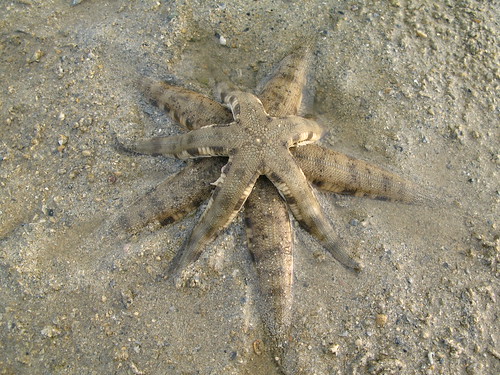I was surprised how many different starfish and brittle stars will "do it" And when and where does it occur?

A mystery.
Almost all of the other taxa I was able to learn about were either temperate-cold water or lived in the deep-sea with Archaster being one of the only tropical species I was able to find info on as exhibiting pseudocopulation
Interestingly, in these other colder water taxa, pseudocopulation is triggered by a change (either an increase or decrease) in tempeature and the time to spawn is much shorter relative to the pseudopulation to spawn ratio in the tropical Archaster.
What else pseudocopulates?? Let's look at some hot starfish on starfish, brittle star on brittle star ACTION!! Bwucka Wow wow! indeed!
1. Leptasterias polaris
From a study by Jean-Francois Hamel and Annie Mercier at the University of Quebec at Rimouski is an account of the large six rayed Leptasterias polaris.
 (from Hamel & Mercier, 1995)
(from Hamel & Mercier, 1995)Pseudocopulation became more frequent in early December and peaked just before the main spawning period in late December as the water temps reached a range of 3-4 degrees.
Unlike Archaster..there is no sex-specific order..just big clumps of Teh pseudopsex!
Then in January..it stops and the stars go back to ignoring each other.
2. Neosmilaster georgianus
From the Antarctic we have the asteriid starfish Neosmilaster georgianus as reported by Marc Slattery and Sid Bosch!
N. georgianus was reported to reproduce throughout the year but the pseudocopulatory behavior was observed in the austral spring/summer in September/October.
Before the action starts, there is "exploratory contact behavior" as the animals touch each other up with males initiating contact with females.
 (from Slattery &Bosch, 1993)
(from Slattery &Bosch, 1993)This is followed by the males mounting the females (so in this species the female is on the bottom). Sometimes 3 or more males will be involved... But in all cases only the bottom one is female!
Because the attraction of males to females is thought to be rooted in pheromones or some other chemotactic stimulus, its possible that one male pairing might actually attract other males to a reproductively active female!
This whole thing takes place over the course of minutes to hours. Interestingly, pairing events were observed to be relatively rare throughout the population studied.
Spawning happens a few hours later (as opposed to 2 months in the tropical Archaster)
On the whole, this suggested that at least for the study area, reproduction occurred at low rates throughout the year.
 (from Slattery & Bosch, 1993)
(from Slattery & Bosch, 1993)3. Ophiura robusta
 (from Himmelman et al., 2008)
(from Himmelman et al., 2008)Finally, a neat article on Arctic/subArctic pseudocopulation and other "aggregative" reproductive behavior from the Gulf of St. Lawrence by John Himmelman and others!
Their paper not only observed mass spawning in ophiuroids but also the asteriid, Asterias vulgaris (=Asterias rubens). Perhaps something like this?
Among these ophiuroids, including Ophiura robusta and Ophiopholis aculeata, some would wrap its arms around the central disk or engage in a seething orgy of reproductive optimization!! in which 3 to 5 of individuals would wrap their arms around each other!!
Interestingly, animals in this region began their spawn in the summer (as opposed to Leptasterias polaris which lives in a similar kind of environment) in reaction to increasing (vs. decreasing in L. polaris) temperature!
Ultimately, these would spawn, with animals crawling up to high platforms or elevated surfaces with the disk raised to "optimize fertilization success".
This gallery has some AWESOME pictures of ophiuroid spawning with this posture..
4. Unknown Deep-Sea Bahamian ophiuroid.
sorry. I got nothing on this.. But pretty cool, eh? I'm not even sure what species? Maybe Ophiomusium?
 So..on that note...have a great pseudocopulating weekend!
So..on that note...have a great pseudocopulating weekend!

So do they all broadcast spawn together while pseudocopulating? Or is there some other method of fertilization? Inquiring minds must know!
ReplyDeleteThe timing depends, but generally, the pseudocopulating "opens" the reproductive season with spawning following sometime after... The spawning occurs readily in the Arctic taxa but two months later in the tropical taxa..
ReplyDeleteThe Antarctic beast did so more or less immediately but very infrequently and constantly vs. seasonally..
Hi Chris, nice topic, have you got a reference for the Ophiomusium? photograph?
ReplyDeletethe ophiomusium pic is from this book...
ReplyDeletehttp://www.amazon.com/Reproduction-Biology-Recruitment-Deep-Sea-Benthos/dp/0231080042/ref=sr_1_1?ie=UTF8&s=books&qid=1289938455&sr=8-1